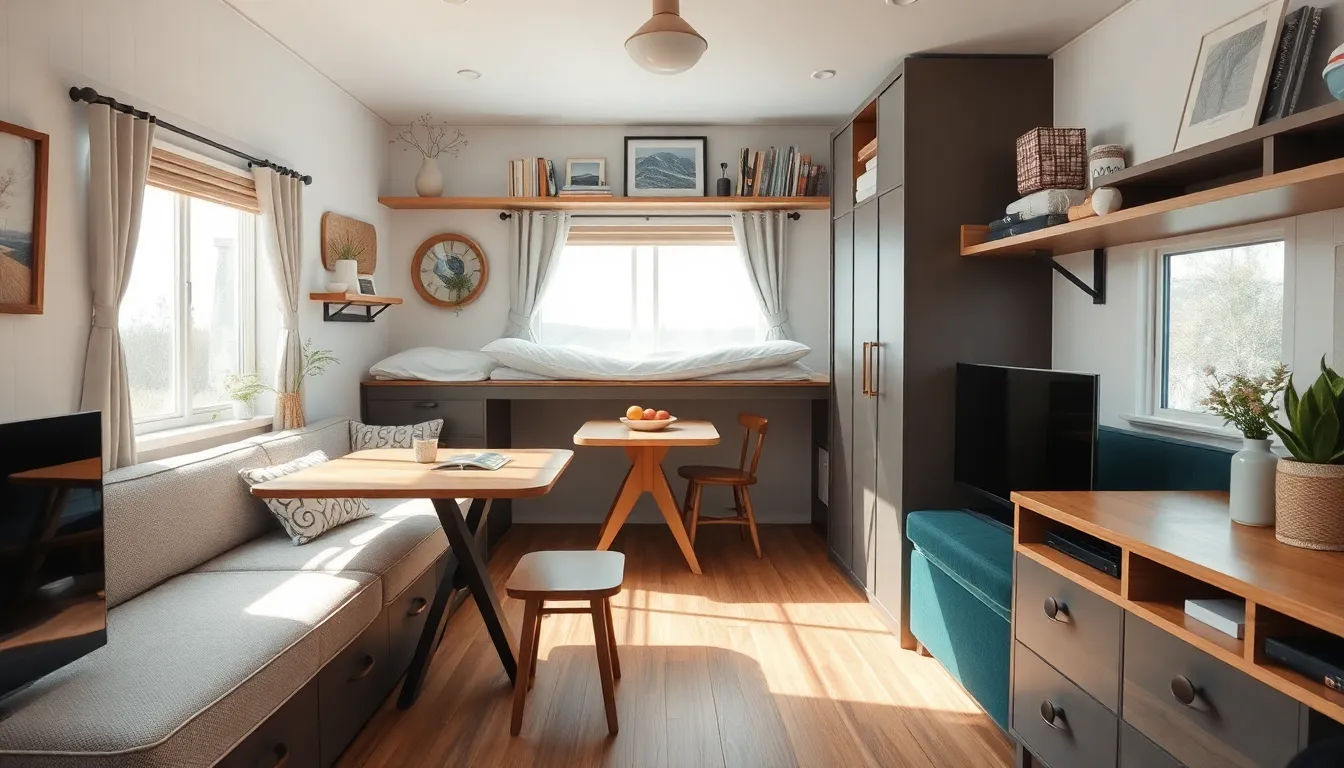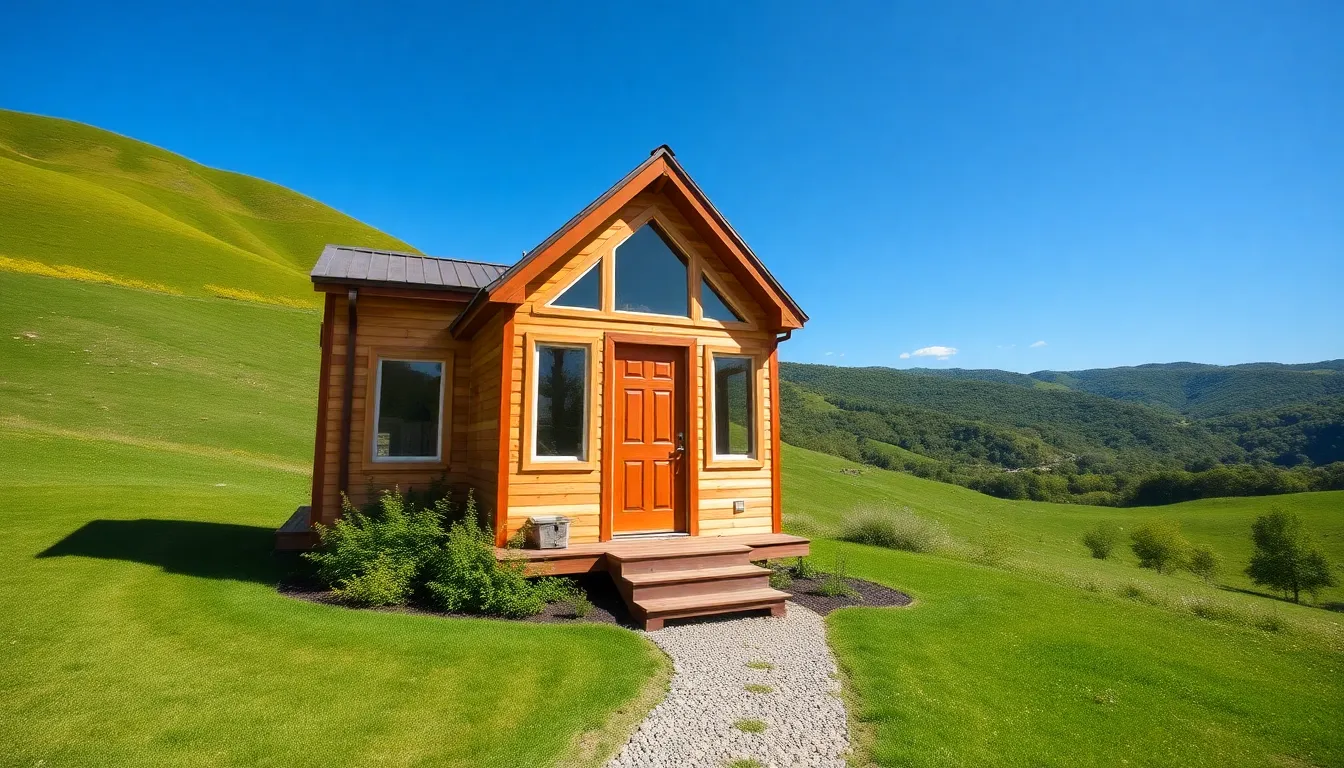Tiny homes are taking the world by storm, proving that good things really do come in small packages. Imagine living in a space that’s not only cozy but also packed with clever features designed to maximize every square inch. From multifunctional furniture to innovative storage solutions, tiny homes are redefining what it means to live large in a smaller footprint.
But don’t let the size fool you—these pint-sized wonders are brimming with personality and charm. Whether it’s a fold-down desk that doubles as a dining table or a hidden loft that makes bedtime feel like an adventure, tiny home features are all about creativity and efficiency. So get ready to discover how these compact dwellings can inspire a simpler, more fulfilling lifestyle without sacrificing style or comfort.
Table of Contents
ToggleOverview of Tiny Home Features
Tiny homes offer a range of features designed to maximize functionality while maintaining comfort. Multifunctional furniture serves as a cornerstone of tiny living. Examples include sofa beds that transform into sleeping spaces and tables that extend to accommodate guests.
Innovative storage solutions play a critical role in tiny homes. Under-bed drawers and built-in shelves allow residents to efficiently use vertical space. Utilizing nooks and crannies for storage keeps living areas clutter-free.
Natural light enhances the appeal of tiny homes. Large windows and skylights create an open, airy atmosphere. A well-lit space often feels larger, contributing to a sense of comfort.
Compact kitchens in tiny homes come equipped with essential appliances. Many include space-saving designs, such as pull-out pantries and stackable dish racks. Efficient layouts encourage organized cooking and dining experiences.
Outdoor living is another important feature of tiny homes. Small decks and porches offer extra relaxation space. These outdoor areas often extend the home’s usable footprint during pleasant weather.
Energy-efficient systems help tiny homes maintain sustainability. Solar panels provide renewable energy, reducing electricity costs. Tankless water heaters save space and promote eco-friendly lifestyles.
Personalization is integral to tiny home design. Unique architectural elements, such as rustic beams or vibrant colors, provide character. Custom touches reflect the owners’ personalities, making each space feel special.
Overall, tiny homes integrate innovative features that optimize space, enhance aesthetics, and promote an efficient lifestyle.
Design Elements

Tiny homes prioritize efficient design elements that enhance both functionality and aesthetics. Features maximize every square foot while maintaining comfort and style.
Space Optimization
Space optimization techniques transform limited areas into multifunctional spaces. Designers often utilize built-in furniture, such as fold-out tables and wall beds, which create extra room when needed. Clever layouts prioritize open floor plans, allowing seamless movement and operations. Nooks and corners often serve as storage solutions instead of leaving them unused. Vertical space becomes essential, with shelves extending to the ceiling to draw the eye upward, creating an illusion of spaciousness. These strategies not only maximize utility but also contribute to a visually appealing environment.
Modular Furniture
Modular furniture exemplifies adaptability in tiny home design. Pieces easily rearrange to serve various purposes, such as a couch that converts into a guest bed. Many options feature storage compartments, allowing residents to stow belongings within their furnishings. Stackable chairs and tables lend versatility for entertaining or everyday use. Designers often select lightweight materials to streamline moving and reconfiguring spaces. This type of furniture complements the minimalism inherent in tiny homes while ensuring a distinctive and stylish living experience.
Sustainability Features
Tiny homes often prioritize sustainability with innovative features that minimize environmental impact. These homes frequently incorporate eco-friendly solutions in various aspects of their design.
Eco-Friendly Materials
Sustainable materials form the backbone of many tiny home constructions. Bamboo offers a durable, renewable alternative to hardwood, while reclaimed wood reduces waste and adds character. Recycled metal and glass often find their way into tiny homes, enhancing architectural aesthetics and promoting recycling. Additionally, non-toxic paints and finishes ensure healthier living environments, contributing to overall well-being.
Energy Efficiency
Energy efficiency plays a crucial role in tiny home design. Solar panels installed on rooftops capture and convert sunlight into electricity, reducing reliance on traditional power sources. Tankless water heaters provide hot water on demand, minimizing energy waste and saving space. High-quality insulation, often used in compact designs, retains heat during winter and keeps homes cool in summer. Smart home technologies can also optimize energy consumption, allowing residents to monitor and control usage effectively.
Functional Amenities
Tiny homes feature functional amenities designed to maximize efficiency and comfort. Each space serves multiple purposes, enhancing the overall living experience.
Kitchen and Bathroom Solutions
Compact kitchens include high-quality appliances, allowing residents to prepare meals without sacrificing style. Multi-functional islands often double as dining areas and extra storage. Sleek cabinetry contributes to a clutter-free aesthetic, reinforcing organization. In bathrooms, space-saving fixtures like floating vanities make room for more storage. Showers with built-in shelves optimize space, while composting toilets promote eco-friendly living. Efficient layouts ensure these essential areas remain functional and stylish in limited square footage.
Smart Home Technology
Smart home technology streamlines daily tasks, offering convenience in tiny living. Devices like smart thermostats adjust temperatures based on preferences, enhancing energy efficiency. Automated lighting systems allow users to control ambiance with ease, creating inviting atmospheres. Security options, including cameras and alarms, provide peace of mind in small homes. Smart appliances, such as refrigerators and ovens, optimize energy usage without sacrificing performance. Integrating these technologies enhances the overall tiny home experience, making life simpler and more efficient.
Outdoor Living Spaces
Outdoor living spaces enhance the charm of tiny homes, creating extensions that maximize usability. Decks or patios provide areas for relaxation and entertaining, allowing residents to enjoy nature. Gardening opportunities abound, with vertical gardens and container plants helping to beautify small exteriors while promoting sustainability.
Furniture designed for the outdoors, like foldable chairs and collapsible tables, easily complements limited space. These features ensure that outdoor areas remain functional and stylish, regardless of size. An outdoor grill or kitchenette can also enhance cooking experiences, making it convenient to cook and dine alfresco.
Pergolas and awnings offer shade, making outdoor living more enjoyable during warm months. Smaller outdoor furniture sets encourage a cozy setting, promoting socialization without overwhelming the area. Enclosed spaces like sunrooms can serve as additional retreats, blending indoor comfort with outdoor views.
Lighting plays a key role in outdoor spaces, with string lights or lanterns enhancing the ambiance for evening gatherings. Fire pits create warmth and become focal points for relaxation, encouraging outdoor activities year-round. Emphasizing comfort and style, sustainable materials for outdoor furnishings and décor can reduce the environmental impact.
Creating a seamless flow between indoor and outdoor living enhances the overall tiny home experience. Large sliding doors or bi-fold windows can open up to outdoor spaces, inviting natural light and fresh air inside. These elements bring together the comfort of indoor living with the beauty of nature, making tiny homes more enjoyable and inviting.
Tiny homes embody a unique blend of creativity and functionality. Their innovative features not only maximize space but also elevate the living experience. By prioritizing sustainability and efficiency, these homes encourage a lifestyle that values simplicity and environmental consciousness.
The charm of tiny homes lies in their ability to reflect personal style while incorporating practical design elements. From multifunctional furniture to inviting outdoor spaces, every aspect is thoughtfully crafted to enhance comfort and usability. As more people embrace this lifestyle, tiny homes continue to inspire a shift towards mindful living and a deeper connection with one’s surroundings.






